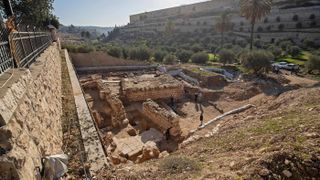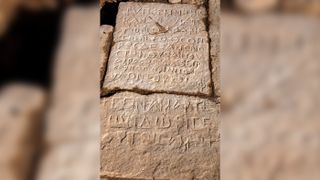Ritual bath unearthed at site where Judas betrayed Jesus

Archaeologists have discovered the remains of an ancient ritual bath church at Gethsemane, a place near Jerusalem where the Bible says that Jesus was betrayed by Judas and arrested.
The 2,000-year-old ritual bath, called a "mikveh," is the only known archaeological find at Gethsemane that dates to the time when Jesus lived, archaeologists from the Israel Antiquities Authority (IAA) and the Studium Biblicum Franciscanum, who jointly excavated the site, said in a statement.
"The discovery of this bath, unaccompanied by buildings, probably attests to the existence of an agricultural industry here 2,000 years ago — possibly producing oil or wine. The Jewish laws of purification obliged workers involved in oil and wine production to purify themselves," Amit Re'em, a Jerusalem district archaeologist for the Israel Antiquities Authority, said in the statement. The name Gethsemane is derived from the Hebrew word for "oil press," he added.
Related: The Holy Land: 7 amazing archaeological finds
A 1,500-year-old church found at the site was likely built when the Byzantine Empire ruled the area, though people continued to use itd after the Muslims took over the area around A.D. 640, archaeologists said in the statement. The church is made of finely carved stone, with a Greek inscription that reads (in translation):
"For the memory and repose of the lovers of Christ [cross sign]. God who has received the sacrifice of Abraham, accept the offering of your servants and give them remission of sins. [cross sign] Amen" (Translation by Leah Di Segni and Rosario Pierri)

Biblical importance
According to the Bible, Jesus was arrested by a crowd that included Judas, who identified Jesus by kissing him. Jesus was then brought before Pontius Pilate, the Roman prefect of Judea, who tried Jesus and sentenced him to be crucified.
Sign up for the Live Science daily newsletter now
Get the world’s most fascinating discoveries delivered straight to your inbox.
This makes Gethsemane, which was the site of his arrest and betrayal by Judas, important to many modern-day Christians. "Gethsemane is one of the most important sanctuaries in the Holy Land, because in this place the tradition remembers the confident prayer of Jesus and his betrayal and because every year millions of pilgrims visit and pray in this place," Br. Francesco Patton, Custos of the Holy Land, said in the statement. The Custos of the Holy Land is appointed by the Vatican and is one of the most senior church officials in the region.
Future pilgrims to Gethsemane will be able to see the new discoveries, archaeologists said. The "recently discovered archaeological remains will be incorporated in the visitors' center being built at the site and will be exhibited to tourists and pilgrims, who we hope will soon be returning to visit Jerusalem," Re'em said.
Originally published on Live Science.

Owen Jarus is a regular contributor to Live Science who writes about archaeology and humans' past. He has also written for The Independent (UK), The Canadian Press (CP) and The Associated Press (AP), among others. Owen has a bachelor of arts degree from the University of Toronto and a journalism degree from Ryerson University.
Most Popular

